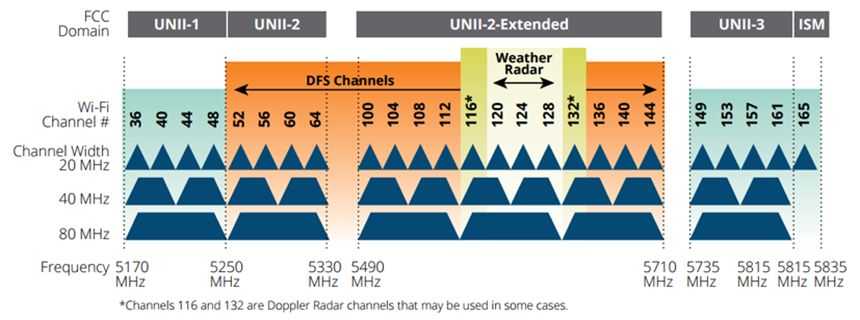

Written by David Meaney, Vice President of Global Technical Sales and Marketing at ECS Inc. International
The demand for wireless access from users has shifted from a luxury, to a necessity. The need for bandwidth is growing exponentially. This has caused network performance to become critical for businesses and consumers alike. Everyone has come to expect their Wi-Fi connection be reliable and fast.
Technology has come a long way in just a few short years. The rapid increase in the need to work from home as well as the types of usage and traffic the networks are contending with has caused the current networks to be over tasked. Because of this the wireless standards need to keep pace. Besides bandwidth, the biggest issue with networks is latency. Latency is the pause in connection as the network tries to keep up with traffic. This has adverse effects on any live event like video conferencing, gaming, voice, and IoT traffic.
To help alleviate the problem of latency, there was a need to develop wireless networks that are more efficient in handling the expanding bandwidth hungry traffic. A new standard called 802.11ax was introduced in 2018. The Wi-Fi Alliance renamed it Wi-Fi 6. One of the main focuses of Wi-Fi 6 was to enhance the efficiency of how access points handle multiple devices.
Speed is no longer the measuring stick for a Wi-Fi network. It is now about how the network would handle many clients at once without dreadful latency issues. We can now look at it as not having more speed to move data, but as having wider bandwidth. Essentially you would have more simultaneous network connections instead of a single connection trying to move data as fast as possible.
Wi-Fi 6 (802.11ax) offers a better overall solution for moving large amounts of data and accommodating many network connections.
What is WiFi 6?
Wi-Fi 6 is the latest standard from the Wi-Fi Alliance based on the 802.11ax protocol, and provides critical capabilities needed for next generation enterprise requirements.
Wi-Fi 6E: The Future!
Wi-Fi 6E grants access to the underutilized 6 GHz frequency band and yields amazing new promises for wireless networking.
These latest Wi-Fi protocols are essentially adding a turbo feature to our existing Wi-Fi that builds upon todays Wi-Fi capabilities. They will be used in technologies from AI and IoT, to supporting 5G. Wi-Fi 6 should all but eliminate latency in time critical applications.
2.4 GHz, 5.9 GHz, and 6 GHz: Fast Forward to the Future
Why does the FCC need to open the 2.4 GHz and 5 GHz spectrum when they are already delivering fast multi-gigabyte speeds and ultra-low latency? In 2019, there were 7.6 billion connected devices. It is expected that by 2030 the global market for connected devices will exceed 25 billion. These connected devices will generate over 150 zettabytes (ZB) of data, that number is equal to 150 trillion gigabytes.
These wireless devices would be connected through many different wireless protocols including Wi-Fi 6, 5G, C-V2X, Bluetooth 5, Zigbee, Z-Wave, and many others being developed today. Based on projections of growth the FCC has determined that it will need to allow unlicensed use of up to 1.6 GHz of mid-band spectrum by 2025.
The 2.4 GHz band has 100 MHz of bandwidth, and the 5 GHz band has 665 MHz of bandwidth. While opening the 5.9 GHz band adds an extra 45 MHz of bandwidth, the new 6 GHz band will provide as much as 1,200 MHz of bandwidth. When these additional bandwidths become available it will open the door for virtually everything to be wireless. For example, autonomous vehicle communications will be possible.
Figure 1 illustrates the 2.4 GHz bandwidth using multiple channels.



What makes Wi-Fi 6 work?
The Wi-Fi 6 standard uses new advancements in wireless technology such as OFDMA, MU-MIMO, and TWT to support dozens of high bandwidth connections at a time.
Wi-Fi 6 addresses the biggest challenges for all Wi-Fi networks: the increasing number of devices and the diversity of their applications. In order to handle these challenges, 802.11ax increases bandwidth throughput by as much as four times over that of the previous 802.11ac standard. Other Wi-Fi 6 improvements include the ability to use both the 2.4 GHz and 5 GHz bandwidths to manage traffic. However, the biggest advancement in the 802.11ax is the multi-user performance called OFDMA (Orthogonal Frequency Division Multiple Access). This allows many devices with different bandwidth needs to be connected and access the network simultaneously. This is an upgrade to older wireless standards when devices needed to queue up and compete with one another to send and receive data. When accessing through an 802.11ax network there is no competition since each device is simultaneously able to transmit and receive data independently. Managing the available bandwidth using the 802.11ax protocol allows the network to handle large amounts of data. Those that are latency sensitive such as voice and video, can be handled simultaneously.
Another protocol for handling high traffic from multiple devices is Time Multi-User Multiple Input/Multiple Output (MU MIMO) originally introduced in 802.11ac. It has been upgraded for use with 802.11ax and is now capable of supporting up to eight devices to transmit and receive simultaneously using a dedicated channel per device. MU MIMO has the added benefit to support large amounts of data such as streaming HD video while low bandwidth data from IoT devices and voice data would be better handled using OFDMA.
An additional benefit of the Wi-Fi 6 protocol is that it supports Target Wake Time (TWT) which lets devices remain inactive until it’s their turn to transmit data using a scheduling scheme negotiated with the access points. Since devices can go into an inactive mode, the battery life of smart phones, tablets, and IoT devices is extended as an underlying benefit. IoT greatly benefits from TWT with an operating mode for low-power devices, low-bandwidth devices like sensors, industrial automation and medical devices. The 802.11ax access point is going to separate devices between a 2.4 GHz or 5GHz bands based on their data requirements.
The efficiency advancements of the 802.11ax are clearly seen as a much faster network and improved access for all the clients on the network. The 802.11ax protocol does greatly enhance the ability of Wi-Fi networks to handle much more traffic, including voice and video streaming in high-density environments. The introduction of 802.11ax comes at the perfect time, as it better utilizes both the 2.4 GHz, 5 Ghz, and 6 GHz Wi-Fi spectrums.
Reliable Electronic Component Manufacturing for Wi-Fi 6 Applications
As a leading manufacturer of electronic components for wireless technology, ECS Inc. has developed many new products designed to enhance the performance of wireless connectivity. ECS Inc. works closely with the engineering community to develop products to meet today’s stringent performance requirements. ECS Inc. understands which component is best suited for industrial, medical, automotive, communications, and all IoT wireless applications.
ECS is proud to serve our global OEM designers and the engineering communities. By helping them receive the engineering support and customer service care that they need.
For more information on Wi-Fi 6, you can visit this link. https://www.wi-fi.org/
| 32.768 kHz Tuning Fork Watch Crystals | ||||
|---|---|---|---|---|
| Part Series | Frequency | Tolerance/Temperature Range |
Package Size | Inventory |
| ECX-1210 | 32.768 kHz | 20ppm, -40°C ~ 105°C | 1.2 x 1.0 mm | Search Inventory |
| ECX-12Q | 32.768 kHz | 20ppm, -40°C ~ 125°C | 2.0 x 1.2 mm | Search Inventory |
| ECX-34S | 32.768 kHz | 20ppm, -40°C ~ 125°C | 3.2 x 1.5 mm | Search Inventory |
| Crystals | ||||
|---|---|---|---|---|
| Part Series | Frequency Range |
Stability/Temperature Range |
Package Size | Inventory |
| ECX-1637B | 16 ~ 50 MHz | 20ppm, -40°C ~ 105°C | 2.0 x 1.6 mm | Search Invntory |
| ECX-2236B | 12 ~ 50 MHz | 20ppm, -40°C ~ 105°C | 2.5 x 2.0 mm | Search Inventory |
| ECS-3B | 10 ~ 54 MHz | 20ppm, -40°C ~ 105°C | 3.2 x 2.5 mm | Search Inventory |
| Oscillators | ||||
|---|---|---|---|---|
| Part Series | Frequency Range |
Stability/Temperature Range |
Package Size | Inventory |
| ECS-2520SMV | 8 ~ 60 MHz | 10ppm, -40°C ~ 105°C | 2.5 x 2.0 mm | Search Inventory |
| ECS-3225SMV | 8 ~ 60 MHz | 10ppm, -40°C ~ 105°C | 3.2 x 2.5 mm | Search Inventory |
| Power Inductors | ||||
|---|---|---|---|---|
| Part Series | Inductance Range | Temperature Range |
Package Size | Inventory |
| ECS-MPI2520 | 0.47 – 4.7 µH ± 20% | -40°C ~ 105°C | 2.5 x 2.0 mm | Search Inventory |
| ECS-MPI4040 | 0.09 – 22 µH ± 20% | -55°C ~ 125°C | 4.7 x 4.31 mm | Search Inventory |
| ECS-MPIL0530 | 0.68 – 22 µH ± 20% | -55°C ~ 125°C | 5.49 x 5.18 mm | Search Inventory |
For more technical resources, please reference our library of technical guides, educational video library on frequency control and product information, our reference design library or our current product catalog.
Please contact us if you need additional information or have a specific requirement in your application.
ECS Inc. International
15351 West 109th Street
Lenexa, KS 66219
Tel: 913-782-7787
Toll Free: 1-800-237-1041
Fax: 913-782-6991
What Is 802.11, 802.11ax, Wi-Fi 6, And Wi-Fi 6E? was last modified: October 16th, 2023 by